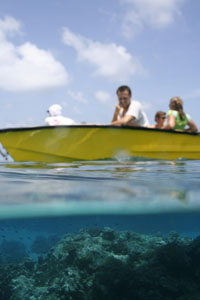December 5 - 18th, 2007
This reef was also studied by PCRF in 2003. Please refer to the links to the 2003 study at the top of each page for comparative data sets.
Fringing.
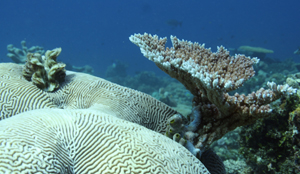 |
| View of shallows |
Uratu is a flat coral island west of Kitava Island in the Trobriand Island group, separated from Kitava by a sandy channel with strong current flow. Uratu is approximately 0.05 km3 and is an uninhabited island. It is owned by one of the chiefs of Kitava, who allows the islanders to use the small island for rest and recreation.
Papua New Guinea (PNG) is a tectonically active area of the world. Locals from Kitava recall the November 2000 tsunami from an 8.2 magnitude earthquake that devastated significant parts of the coast. The tsunami disrupted fish populations and shallow areas of Uratu’s reefs. Again in 2002, an earthquake of a magnitude of 7.5 hit the region (Ippers, 2004).
The Kitava region and other outer islands of the Milne Bay Province were strongly affected by the tropical cyclone Adel in 1993. PNG lies just outside the offical tropical cyclone belt of the South Pacific but is hit with an average of one cyclone each year (INC, 2000). We experienced a small tropical cyclone Guba while anchored at the mouth of Milne Bay a month prior to the study in Kitava with gusts of wind reaching 40 knots.
Subsistence fishing is still essential to the communities on Kitava. The land of Kitava is owned by clans of different families, but the reef belongs to the whole community and everyone can harvest fish, invertebrates, and seaweeds as they need (Ippers, 2004).
Since the Second World War, the shipping route for large cargo ships between Kitava and Kiriwina has increased in activity. In 2003, an average of 20 cargo ships were sighted each day (Ippers, 2004). Over the two week study in 2007, there were 141 cargo ships sighted with an average of 8.8 ships each day. The distance between the major shipping lane and Kitava is approximately 4 nautical miles. The only evident impact from the ships to Kitava is large rolling waves that increase the turbulence and disturb the natural water patterns around the islands.
This reef is bordered on its east side by a narrow sand channel separating it from Kitava Island. The contours of this channel have changed over time, including in the four years since this reef was last studied by PCRF. The northern extremities of the reef have not changed. However, differences in both the strength and direction of currents were observed compared to the 2003 study.
The average water temperature recorded over the two-week period was 28.4°C. The average horizontal visibility was 25.8 metres. Daily strong tidal currents made the vertical visibility a challenge to obtain. An average of two vertical measurements was 25.7 metres.
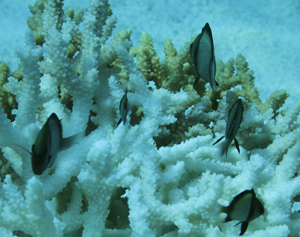 |
| Acropora sp. colony bleaching |
Bleaching was observed on several coral colonies. One massive Porites colony very close to the beach had two small areas of freshly bleached tissue. Another table Acropora colony in a depth of about 8 metres was in the process of bleaching from the centre of the colony towards its edges. Analysis of the Vitareef data resulted in 0.51% of colonies in the shallow zone and 0.19% in the deep zone affected by bleaching.
Crown of thorns sea stars were not present on any transect sites, however three individuals were noted off transect during separate study dives.
One table Acropora colony was observed to have a ‘wasting’ disease on its periphery. This condition has also been sighted by PCRF in the Anambas Islands in Indonesia. Disintegration of tissue and skeleton appears to occur close to the end of a branch and fragments of branches fall to the substrate below the colony. Several incidences of white band disease were also observed on table Acropora colonies including one colony observed in the Vitareef deep zone.
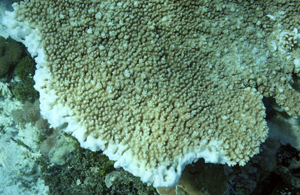 |
| wasting disease on edges of Acropora sp. table |
Comparing Vitareef results from 2003 and 2007, there is little significant change in the condition of the hard coral colonies on this reef. In 2003, 32.3% of corals were scored as healthy. In 2007, this figure was 30.8%. A slight increase in the level of threat scored in 2007 correlates well with this slight decrease in the overall level of health. In 2003, threat was scored as 56.9% and in 2007, it was 61.2%.
The predominant condition affecting these colonies is still overgrowth by algae. In 2003, algal overgrowth was scored at 46.1% and this figure in 2007 had increased slightly to 48.1%. Algae overgrowing living coral tissue included Halimeda, encrusting calcareous algae, and the combined filamentous algae/sediment condition known as ‘edge damage’.
However, settlement of sediment on living coral tissue has decreased over the last five years from 28.6% to 8.8%. At the time of the 2003 study, the effects of recent tsuamis were still being felt on this reef. It appears that the resettling of the sand in the channel to the east of the reef was complete by the 2007 study, with shifting sedimentation less of a problem. Most sedimentation was caused by calcified segments of Halimeda.
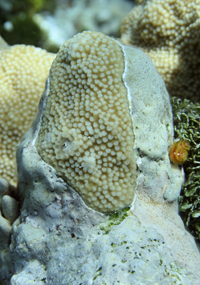 |
| coralline algae smothering Isopora sp. |
Dominant coral species of Uratu’s fringing reef include Porites, Montipora, Isopora, Pocillopora, and Acropora species.
Robust coral colonies such as Isopora and Porites sp. were better adapted to avoid smothering by macroalgae and sedimentation.
Dead and dying corals were present on the reef, but newly formed small colonies of Acropora and Pocillopora were abundant over all areas of the study site.
Strong tidal flows were noticed on the reef over the study period. This constant flushing either greatly increased the turbidity of the water with thermocline mixing of particulate matter or provided lucid, slack conditions.
Soft mushroom leather coral, genus Sarcophyton, has retained its hold over both healthy and damaged areas of the reef. Overgrowth by Sarcophyton was already an issue in 2003. An abundance of invertebrates, chiefly hermit crabs, were found in the majority of Pocillopora species. Corallivorous snails were not significantly present on corals.
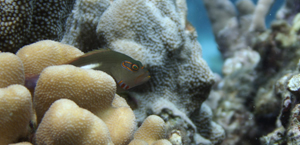 |
| arc eye hawkfish on Stylophora sp. |
In 2003, 92 species of fish were observed over the course of two transect dives. The total number of fish observed was 1,472. Predatory species sighted included nine species of snapper, two of grouper, three of emperor and one of mackerel. In 2007, 138 species were observed over the course of four transect dives. The total number of fish observed was 3,830. Predatory species sighted included four species of snapper, three of grouper, one of emperor, two of jacks and one mackerel tuna. The comparative increase in diversity observed in 2007 is most likely due to conducting more fish surveys during this study.
General observations over the course of the 2007 study proved that the shallow reef surrounding Uratu is very much a nursery reef, with juveniles of many species found in depths of up to ten metres. Tidal currents have a strong influence on sightings of predatory fish, with jacks and mackerel tuna observed towards the edge of the reef slope and in strong current.
Invertebrates that damage and weaken the internal skeleton of living hard corals were numerous at each transect site. For example, the Christmas tree worm Spirobranchus giganteus; the bioeroding scallop Pedum spondyloideum; worm snails and spaghetti worms were commonly observed inhabiting corals. Some corallivorous snails were present, especially noticeable on digitate corals such as Porites fingers; however, the majority of the corallivorous snail shells seen on the reef were actually housing small hermit crabs. Also, hermit crabs of the genus Paguitta were commonly seen residing in the vacant holes of worm snails. Little difference was noted between the invertebrate composition of deep and shallow transect zones.
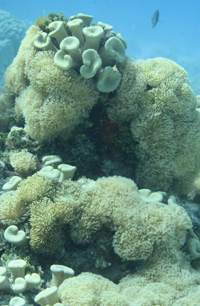 |
| Sarcophyton spp. |
PCRF takes special note of the following invertebrates on each study site: sea cucumbers, sea urchins, crown of thorns sea stars, Trocus turban snails, and giant clams. The Uratu site was lacking in all of these key organisms. No sea cucumbers were noted on the four transects although two were sighted during the course of other dives at the site. The small, thin-spined sea urchin Echinometra mathaei is found occasionally nestled in divots in the coral rock, however these urchins are not known to be an economically marketable or locally favored species. Molluscs favored by native populations as a food source and as materials for locally produced crafts were rare. For example, only one Trocus snail was spotted within the 4 transects. One species of giant clam, Tridacna crocea, was present in our transect sites with four individuals observed at approximately their full-grown size of 15 cm.
Soft corals were prevalent on Uratu reef, with the dominant species being the mushroom leather coral Sarcophyton crassocaule. S. crassocaule was commonly seen smothering weakened scleractinian live coral and growing abundantly on most available coral rock. Various species of the soft coral genus Xenia were also common on Uratu reef.
On the voyage to Kitava via Egum atoll, cetacean life was flourishing. In one afternoon off Egum atoll, 10 bottlenose dolphins, 10 pilot whales, and two false or pygmy killer whales were sighted while under sail. In the anchorage near Kitava and Uratu Islands, bottlenose dolphins were spotted almost daily. From our previous visit, we know that there is a resident pod of bottlenose dolphins in the region. The pod has remained in the channel between the two islands, and off the northwest coast of Kitava. The small bottlenose dolphins varied in number and were sighted both on dives and from Infinity at anchor.
Two sightings are described here in further detail. One encounter near the ship, with a pod of approximately 20 dolphins lasted 20 minutes, as several crewmembers were able to travel along with the pod in the small boat. Dolphins were jumping and surfacing near the small boat and video footage of the sighting was obtained. During a strong current dive at the study site, a pod of 15 small bottlenose dolphins approached divers 100 meters away as divers drifted off the stern of the small boat. When the dolphins surfaced, one was seen to have a cut in its dorsal fin.
Two small whales were also sighted after motoring about ten nautical miles away from Kitava after completing the study, with one separate occurrence of a large blow.
Turtle sightings were rare in Kitava, as tidal flow was strong during our stay. One morning, ten hawksbill turtles were sighted surfacing near the bow of the ship, followed by the resident bottlenose dolphin pod. There are no known turtle nesting beaches on Kitava or Uratu.
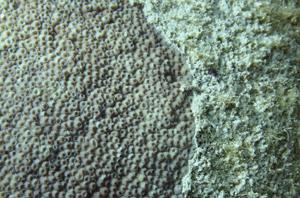 |
| edge damage on Astreopora sp. |
The major threat to this reef appears to be overgrowth by algae, as was the case in 2003. In 2003, disturbances to the reef from recent tsunamis were to blame for the poor state of health of this reef. It appears that the reef has not been able to shake off the deteriorations that set in at that time and continues to struggle against the detrimental conditions of algal overgrowth and sedimentation, although the effects of sedimentation are lessening over time.
INC, (2000). Initial National Communication, Papua New Guinea. “Under the United Nations Framework, Convention on Climate Change.” November, 2000. http://unfccc.int/resource/docs/natc/papnc1.pdf
Ippers, L. (2004) “Environmentally Influenced Structural, Morphological, and Biological Interactions on a coral reef in Milne Bay Province, Papua New Guinea.” University of Applied Science Bingen Environmental Engineering (unpublished thesis)
